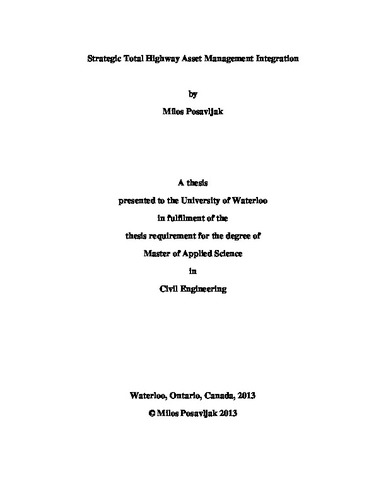| dc.contributor.author | Posavljak, Milos | |
| dc.date.accessioned | 2013-12-10 19:20:01 (GMT) | |
| dc.date.available | 2013-12-10 19:20:01 (GMT) | |
| dc.date.issued | 2013-12-10 | |
| dc.date.submitted | 2013-12-09 | |
| dc.identifier.uri | http://hdl.handle.net/10012/8072 | |
| dc.description.abstract | The last decade has seen significant developments in highway asset management. A key
component to successful asset management is long-term network investment planning. In
order to successfully manage a significant quantity of aging roadway infrastructure and
growing traffic volume, agencies are faced with challenges in developing reliable long
term plans that maximize the network performance through value optimization.
Current practice typically involves relatively independent planning for the bridge and
pavement networks; with a very slight number of situations allowing for reliable trade-off
analysis between the two. While a situation in which the choice to improve two
structures rather than one pavement section may yield a greater percentage increase in the
bridge network performance, than the opposite choice would for the pavement network -
the reliability of this choice being right and at the right time significantly decreases over
time.
Introduction of mutually inclusive highway asset planning in this research, by integration
of the bridges into an equivalent measure of the pavement network results in significant
increases in the long-term planning reliability - is proposed. Data from the Ministry of
Transportation of Ontario is used to demonstrate how this proposed approach would
work. A key point of this Strategic Total Highway Asset Management Integration
(STHAMi) approach is the Conceptual Structural Integration Factor (CSIF). Application
of CSIF and Bridge Condition Index (BCI) integration into a pavement performance
index allows for representation and treatment of bridges as equivalent pavement sections.
This allows for a better comparison of the assets over time.
Compared to the traditional approach of mutually exclusive network level planning,
STHAMi resulted in a higher percentage of network treated per unit of value, coupled
with consistently higher annual network performance over the long-term.
In addition to significantly higher long-term sub-asset trade-off reliability, STHAMi
offers potential for significant increases in organizational efficiency with respect to longterm
highway asset planning. Key benefits include introduction of one pavement
performance indicator as an all encompassing performance indicator for the complete
highway asset, as well as the potential for long-term bridge network level planning
execution within a pavement engineering oriented organizational unit.
Further STHAMi development is recommended through integration of other network
performance measures such as operational and safety indicators. | en |
| dc.language.iso | en | en |
| dc.publisher | University of Waterloo | en |
| dc.subject | STRATEGIC TOTAL HIGHWAY ASSET MANAGEMENT | en |
| dc.title | Strategic Total Highway Asset Management | en |
| dc.type | Master Thesis | en |
| dc.pending | false | |
| dc.subject.program | Civil Engineering | en |
| uws-etd.degree.department | Civil and Environmental Engineering | en |
| uws-etd.degree | Master of Applied Science | en |
| uws.typeOfResource | Text | en |
| uws.peerReviewStatus | Unreviewed | en |
| uws.scholarLevel | Graduate | en |

